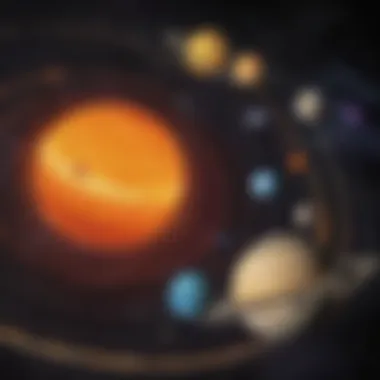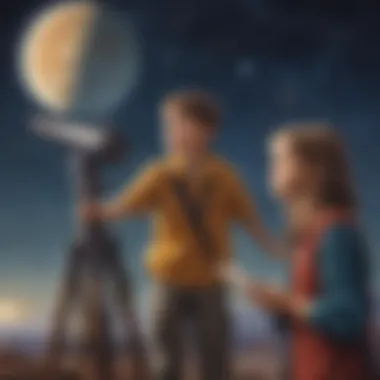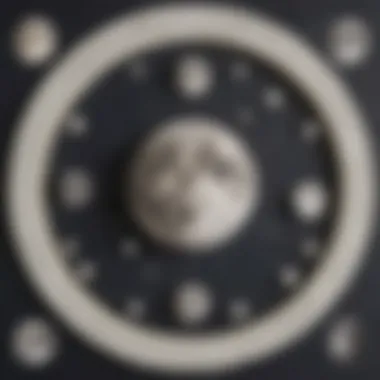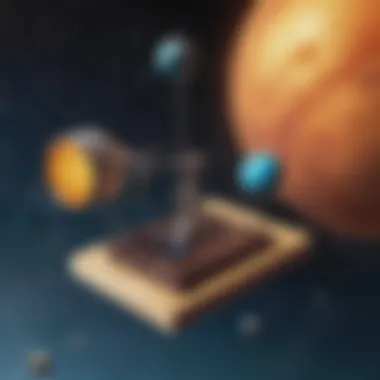Engaging Young Minds: Solar System Experiments


Intro
The solar system is a vast and fascinating place. Young learners can explore this wonder through engaging activities. These activities are designed to pique curiosity about celestial bodies like planets, moons, and stars. By learning through hands-on experiments, children aged six to twelve can grasp complex concepts easily.
This article provides a detailed guide on various experiments that can be conducted at home or in classroom settings. It discusses how these activities nurture scientific inquiry, allowing young minds to connect with basic principles of astronomy.
Science Fun Facts
Exploring the solar system can be made even more exciting with some fun facts!
- The Sun is 99.86% of the mass of the solar system, making it a dominant force.
- Venus spins backward, making it unique among planets.
- Jupiter’s Great Red Spot is a storm larger than Earth that has been raging for centuries.
- Saturn is so light that it could float in water, if a body of water large enough existed.
These fun facts not only pique interest but also provide a foundation for further exploration into each planet's characteristics.
Interesting Trivia and Facts
Known as a gas giant, Jupiter has more than 79 moons! Each of these moons holds unique features that can be discussed during experiments. Similarly, Mars, often called the Red Planet, has the largest volcano in the solar system, known as Olympus Mons.
Quirky Science Stories
One interesting story involves the discovery of the planet Pluto. Initially classified as a planet, it was redefined as a dwarf planet in 2006, stirring up significant debate among astronomers and the public alike. This change highlights how science evolves and encourages children to think critically.
"Science is not only a disciple of reason but, also, one of romance and passion." – Stephen Hawking
Amazing Science Records
- Mercury is the closest planet to the Sun with temperatures ranging from extremely hot to freezing cold.
- Neptune has winds reaching up to 1,500 miles per hour, the fastest in the solar system.
These records not only show the diversity among celestial bodies but also provide an opportunity for experiments on temperature, wind, and planetary motions.
Thought-Provoking Questions
Encourage children to ponder over questions like:
- What would happen if we could stand on the surface of Venus?
- How does gravity differ on the Moon compared to Earth?
These questions can lead to deeper discussions and inspire hands-on investigations.
Discover the Wonders of Science
Diving deeper into scientific concepts makes for a rewarding journey.
Exploring Various Scientific Concepts
Through simple experiments, children can explore gravity and orbits. For instance, using a marble and a flat surface, kids can simulate how planets orbit the Sun. It illustrates gravitational pull in a tangible way.
Educational Videos and Animations
Resources like NASA's website and Britannica offer educational videos that provide visual context for planetary movements and other astronomical concepts.
Interactive Learning Tools
Interactive websites and mobile applications can aid in visualizing planetary positions and distances in the solar system. Tools such as Star Walk 2 or NASA's Eyes on the Solar System can bring the universe to life.
Real-Life Applications of Science
Understanding the solar system fosters skills applicable in various fields, from engineering to environmental science. For example, learning about energy from the Sun is crucial for discussions on renewable energy sources.
Science Experiment Showcase
This section details experiments that captivate young scientists.
Fun and Engaging Experiments
Here are a few experiments you can try:
- Create a model of the solar system using craft supplies.
- Use baking soda and vinegar to create a rocket to demonstrate propulsion.
Step-by-Step Instructions
- Model of the Solar System: Gather foam balls, paint, and a stick to represent planets. Size the balls according to planet sizes and paint them with distinctive colors.
- Rocket Experiment: In a plastic bottle, mix baking soda and vinegar. Seal the cap and step back. Watch the rocket launch!


Materials List
For the solar system model:
- Various sizes of foam balls
- Acrylic paint
- A wooden dowel or stick
For the rocket experiment:
- Plastic bottle
- Baking soda
- Vinegar
- Cap
Safety Tips and Precautions
Always supervise children during experiments. Ensure that materials used are safe. For the rocket experiment, perform it outdoors away from people and flammable items.
This comprehensive guide will help ignite the imagination of young learners, bridging the gap between abstract concepts and hands-on experience. By engaging in these experiments, they will gain insight into the wonders of the solar system, paving the way for a lifelong love of science.
Intro to the Solar System
The solar system serves as a remarkable topic for exploration and education. Understanding its structure helps young learners grasp basic astronomical concepts. The sun, planets, moons, asteroids, and comets all interact in ways that show the vastness of space and the complexity of celestial mechanics. This foundational knowledge is crucial as children develop their scientific inquiry skills.
By introducing students to the solar system early, we cultivate their curiosity. In this article, we explore various experiments that facilitate hands-on learning about space. Teachers and parents alike will find value in these activities, which foster engagement and retention.
Understanding the Basics
To really appreciate what the solar system is, it's essential to define it. At its core, the solar system is made up of the sun and all celestial objects that orbit it. This includes eight major planets, dwarf planets, countless asteroids, and numerous comets. The distances between these bodies are vast, and their sizes vary dramatically.
Learning the basics about the solar system helps young minds visualize their place in the universe. Children can better comprehend larger concepts such as gravity, orbital motion, and natural phenomena like eclipses. Engaging with these ideas through tailored experiments can make them more digestible.
Key components of the solar system include:
- The Sun: A nearly perfect sphere of hot plasma that provides energy.
- Planets: Divided into inner and outer types, each with unique characteristics.
- Moons: Natural satellites that orbit planets, each with fascinating stories.
- Asteroids and Comets: Represent remnants from the solar system's formation.
Why Experiment with Space?
Experimentation with space fosters an environment of inquiry and imagination. When kids conduct hands-on experiments, they engage directly with complex ideas. This mode of learning offers several advantages:
- Interactive Learning: Young learners actively participate, which enhances understanding through doing.
- Curiosity Driven: Children ask questions, explore possibilities, and delve deeper into what interests them.
- Retention of Information: Activities that involve direct engagement help cement knowledge.
The motivation to explore the universe stirs a latent wonder within children. The potential for new discoveries encourages them to continue questioning and learning. By providing these exploratory experiences, we aim to inspire a lifelong love for science, emphasizing the importance of hands-on learning.
"Curiosity is the mother of invention."
Encouraging children to experiment with simple models of the solar system allows them to visualize and understand the vastness of space in a tangible way.
Key Components of the Solar System
Understanding the key components of the solar system is essential for young learners to grasp basic astronomical concepts. By focusing on these components, children can see how everything is interconnected and learn the significance of each element. This section discusses the Sun, planets, moons, asteroids, and comets. These elements provide a framework for experiences that can solidify knowledge in students. This foundation supports scientific inquiry and curiosity.
The Sun: Our Primary Star
The Sun is the heart of the solar system. It is crucial for life on Earth. The Sun provides light and warmth. Without its energy, our planet would be inhospitable. Learning about the Sun introduces children to concepts of gravity and fusion. It serves as a perfect example of how a star influences its surroundings. Experiments can help illustrate the Sun’s importance. One can engage learners by making models of the Sun or using simple materials to show how sunlight travels.
Planets and Their Orbits
Planets are fascinating subjects. They come in various types and sizes. Understanding their orbits around the Sun adds depth to overall solar system studies. The two main categories are inner and outer planets.
Inner Planets
Inner planets include Mercury, Venus, Earth, and Mars. These planets are smaller and rocky. A specific aspect of inner planets is their close proximity to the Sun. This closeness means they experience higher temperatures. This feature makes inner planets popular choices for experiments that show how temperature affects planetary environments. Children can relate to Earth easily. Learning how the environment works and the similarities with other inner planets can spark interest. However, the limited variety compared to outer planets can make them feel less exciting.
Outer Planets
Outer planets consist of Jupiter, Saturn, Uranus, and Neptune. They are much larger and are known as gas giants. The key characteristic is their extensive atmospheres. For this article, their fascinating rings and moons provide engaging topics for young learners. Exploring the diversity among outer planets encourages curiosity. They are beneficial in teaching about gravitational forces and composition of celestial bodies. The vastness of these planets can be overwhelming for some. However, their uniqueness offers rich opportunities for exploration. Thus, they have significant contributions to understanding planetary structures.
Moons and Their Significance
Moons play a vital role in our solar system. Every planet has its own unique set of moons, each with distinct characteristics. For instance, Earth's moon influences ocean tides. Learning about how moons affect their planets can lead to discussions about ecosystems and natural phenomena. This connection is essential for enriching the learning experience. Additionally, experimenting with models can help visualize these effects. Engaging with moons through hands-on activities can further spark interest.
Asteroids and Comets
Asteroids and comets represent two different aspects of the solar system. Asteroids are rocky bodies that mostly exist in the asteroid belt. They provide insights into the early solar system. Learning about asteroids can help children understand the formation of planets and other celestial bodies. In contrast, comets, with their bright tails and trajectories, capture imaginations easily. These icy bodies can be studied to understand the origins of water on Earth. Introducing the concept of comets in experiments makes astronomy more relatable.
The Importance of Hands-On Experiments


Hands-on experiments are a vital part of learning about the solar system, particularly for young learners. These activities allow children to interact directly with scientific concepts. Rather than passively receiving information, students become active participants in their education. Through hands-on experiments, children can explore, question, and discover more about celestial bodies.
One key advantage of hands-on experiments is that they encourage curiosity. Children are naturally inquisitive, and engaging them with practical activities ignites their desire to learn. This approach can help demystify complex astronomical topics, making them more relatable. For example, a simple activity like creating a model of the solar system can help a child understand the relative positions and sizes of planets. This enhances comprehension and retention.
Additionally, hands-on experiments provide opportunities to develop various skills. Young learners learn how to collect data, observe changes, and make conclusions. Such skills are crucial for scientific inquiry. They encourage critical thinking, which is beneficial in all aspects of education.
Experiments also foster collaboration among children. Many activities can be done in groups, teaching teamwork and communication. These social skills are equally essential alongside academic learning.
Learning Through Doing
Learning through doing is a fundamental principle of hands-on experiments. This idea means engaging directly with materials and processes, allowing students to explore scientific principles by themselves. Instead of solely reading about the solar system, kids can build models, simulate orbits, or create comets. These experiences provide a deeper understanding.
Doing activities enhances sensory experiences. Children see, hear, and touch, which can generate excitement about learning. For instance, when building a solar system model, they physically manipulate objects. This interaction makes abstract ideas more concrete.
Moreover, when students conduct experiments, they can make mistakes. Those mistakes offer valuable lessons. Errors are a significant part of the learning process. Each failure gives insight into why something does not work, leading to deeper understanding.
In practical terms, this approach also helps children learn at their own speed. Some may grasp concepts quickly, while others may take longer. Therefore, learning through doing respects individual differences in learning styles and paces.
Engagement and Retention of Information
Engagement is crucial for effective learning. Hands-on experiments inherently promote greater engagement than traditional teaching methods. Children are more inclined to focus on a task that involves action. By participating in experiments, they are likely to remember the information presented.
Retention of information can directly correlate with involvement. Active participants are more likely to keep what they have learned. Involving various senses and actions improves memory. For example, if a child creates a comet from household ingredients, the tactile experience solidifies the learning of what comets are and how they behave.
Furthermore, hands-on experiments can stimulate questions. As children observe and explore, they often ask clarifying questions. This questioning fosters a deeper examination of the subject matter. The result is a richer learning experience.
In summary, hands-on experiments not only engage children but also enhance related retention of information. Combining action with learning results in a more effective educational encounter.
Experiment Ideas for Young Science Enthusiasts
Exploring the solar system can be exciting for young science enthusiasts. Engaging experiments foster curiosity and provide hands-on learning opportunities. Young learners can connect with complex ideas by actively participating in activities that relate to astronomy. Therefore, this section emphasizes accessible and interactive experiments that develop scientific inquiry skills among children aged six to twelve.
Building a Solar System Model
Materials Needed
To create a solar system model, specific materials help children visualize planetary distances and sizes. Commonly used items include:
- Styrofoam balls
- Paints or markers
- Yarn or string for orbits
- A cardboard base for stability
These materials are beneficial because they are easy to find and inexpensive. Using different sizes of balls makes the model scale more accurate, which is crucial when discussing solar system concepts. However, the use of lightweight materials should be considered to avoid difficulty while constructing the model.
Step-by-Step Instructions
Building a solar system model requires clear guidance. Here are effective steps:
- Paint the balls to represent different planets, including unique colors for each planet.
- Attach the planets to the cardboard base using glue or strings, maintaining the correct order from the Sun.
- Label each planet with its name and key facts, encouraging knowledge retention.
These instructions are effective because they provide a straightforward process for young learners. By following clear steps, children can gain a better understanding of spatial relationships between planets, which enhances their learning experience.
Simulating Planetary Orbits
Required Materials
This experiment helps demonstrate gravitational influences on planet movement. Materials include:
- A large ball (representing the Sun)
- Smaller balls (representing planets)
- A flat surface for rolling
These materials make the concept more relatable to children. A large ball provides a solid visual, while smaller balls represent various planets, making the demonstration engaging. One challenge here is ensuring enough space for movement, as confined spaces limit the effectiveness of this simulation.
Experiment Procedure
The procedure for simulating orbits is simple yet impactful. Here's how:
- Place the large ball in the center of the flat surface, representing the Sun.
- Roll smaller balls around the large ball to simulate orbits. Children can experiment with different speeds to observe changes in orbit shape.
- Discuss how gravity affects planetary movement and how distances change the orbits.
This procedure is effective because it encourages interaction with concepts rather than passive learning. Observing the speed and distance can spark questions about celestial dynamics and deepen understanding.
Creating a Comet
Ingredients


Creating a comet is an engaging experiment that combines science and creativity. Ingredients could include:
- Water
- Baking soda
- Corn syrup
- Food coloring, if desired
These ingredients are easy to find in most households, ensuring accessibility for all. Mixing these simple items can represent the components of a comet—ices and dust. However, careful measurement is essential to avoid inconsistencies in the outcome of the experiment.
How to Conduct the Experiment
Conducting this experiment involves a step-by-step guide:
- Mix water and baking soda in a bowl to form a paste.
- Add corn syrup to give it a viscous texture, mimicking a comet's icy structure.
- Form the mixture into a ball and freeze it; this simulates how comets travel through space.
- Discuss how comets form and what their journey through the solar system entails.
This procedure is beneficial since it links theoretical knowledge with tangible creation. It allows children to visualize and understand comet behavior, making this a memorable learning experience.
Analyzing Results and Observations
Analyzing results and observations is a crucial aspect of conducting experiments, especially for young learners exploring the solar system. This stage encourages students to look beyond mere data collection and fosters meaningful connections to the concepts being studied.
The key benefits of this phase include enhancing critical thinking skills and deepening understanding of scientific principles. As students reflect on their observations, they learn to develop explanations that relate to their initial hypotheses. Furthermore, this exploration promotes curiosity, prompting questions that lead to further investigation.
Recording Data
Recording data can take many forms, whether it involves writing in a notebook, using digital applications, or creating charts and graphs. This process not only provides a record of findings but also serves to organize thoughts in a systematic manner. Here are some helpful tips for effectively recording data:
- Use clear headings: Start by labeling each experiment. This organization helps when comparing results later.
- Include observations: Note any unusual occurrences or unexpected results during the experiments. These can be just as important as the data itself.
- Visual aids: Create simple graphs or drawings to illustrate your findings, which can make complex information easier to digest.
- Daily logs: Encourage students to keep a consistent log of their experiments, noting date, time, and environment.
Making Sense of the Findings
After data collection, the next step is making sense of the findings. This process involves analyzing the recorded information and drawing conclusions from it. Here are some valuable methods to help make connections between observations and scientific concepts:
- Compare results with initial hypotheses: Encourage students to evaluate whether their initial thoughts align with what they observed.
- Group discussions: Facilitate discussion among peers to share insights and different perspectives on the data. Different viewpoints can lead to richer understanding.
- Identify patterns: Look for trends in the data that suggest relationships or correlations and encourage students to explain why they might exist.
- Reflect on the process: Ask students to think about what worked well and what didn’t, which can inform future experiments.
"Understanding how to analyze results not only strengthens scientific reasoning but also enhances the joy of discovery. "
Enhancing Scientific Inquiry Skills
The ability to conduct scientific inquiry stands at the core of understanding the natural world, including the vastness of the solar system. Incorporating experiments in the learning process not only promotes curiosity but also cultivates essential skills that are fundamental to scientific exploration. These skills include observing, questioning, hypothesizing, experimenting, and analyzing results. By engaging young learners in hands-on activities, they develop a mindset geared towards inquiry, leading to better comprehension of complex concepts in astronomy.
Critical Thinking Through Experiments
Experiments act as a catalyst for critical thinking. When children participate in hands-on activities related to solar system experiments, they are encouraged to think beyond rote memorization. This is essential. They must analyze their observations and interpret their findings to draw conclusions. For example, when simulating planetary orbits, students must consider variables such as distance from the sun and gravitational pull, leading them to think critically about the relationships between different celestial bodies.
Some strategies to stimulate critical thinking include:
- Asking open-ended questions: Encourage children to think deeply about their experiment outcomes.
- Encouraging discussions: Allow them to share their findings and thoughts with peers, which promotes collaborative learning.
- Reflecting on results: Have them write or express what they learned, fostering deeper understanding.
"The essence of scientific inquiry lies in the questions that drive investigations and the tests that explore their validity."
Encouraging Questions and Exploration
Promoting a culture of inquiry also involves encouraging questions. When learners feel comfortable asking questions, it opens the door to exploration. For instance, after conducting an experiment such as creating a comet, educators should invite students to ask about the composition of comets, how they travel through space, or their significance in understanding the solar system. This not only reinforces the knowledge gained, but also enables them to connect concepts across various subjects.
To cultivate an environment where questions are welcome, educators and caregivers can:
- Model curiosity: Demonstrating how to ask questions ignites interest in exploration.
- Celebrate inquisitiveness: Recognize and value the questions children pose. It helps them understand that inquiry is a vital part of learning.
- Provide resources: Offer books, articles, and online resources that can answer their questions and broaden their understanding.
Encouraging questions promotes a lifelong love of learning. It’s a step towards developing not just future scientists, but critical thinkers who can tackle a variety of challenges.
By emphasizing scientific inquiry skills, we lay the groundwork for children to navigate and understand the complexities of the solar system and beyond.
Resources for Further Exploration
Understanding the solar system goes beyond experimentation. It involves continuous learning through various resources that enhance knowledge and stimulate interest. The topic of resources for further exploration is vital in this article, offering readers tools to delve deeper into astronomy and scientific inquiry. Having access to well-researched materials cultivates a broader understanding of the universe and its components. Engagement in such resources adds depth to simple experiments, transforming them into profound learning experiences.
Books and Articles on Astronomy
Books and articles serve as foundational elements in the journey of discovery about the solar system. They provide comprehensive insights and expertly curated information that engage young minds and spark curiosity. Resources aimed at elementary school children typically utilize engaging illustrations and simplified concepts. Prominent works include:
- "The Solar System" by Seymour Simon: This book captures key facts about planets with vivid imagery, drawing interest from young readers.
- "There's No Place Like Space: All About Our Solar System" by Tish Rabe: Utilizing a playful narrative, this book introduces readers to the wonders of space in an engaging manner.
When combined with hands-on experiments, these books become catalysts for exploration. They not only present knowledge but also encourage young readers to ask questions and seek answers.
Online Platforms and Educational Websites
In our digital age, online platforms and educational websites are indispensable for learning about the solar system. They offer interactive experiences that can augment the experiments discussed in this article. Websites like NASA's education portal provide downloadable resources, activities, and multimedia that capture the intrigue of space exploration. Moreover, platforms such as Khan Academy offer free lessons that break down complex topics into manageable segments.
Additionally, community discussions on forums like Reddit allow users to share insights and discoveries about astronomy. These platforms can enhance critical thinking and foster a deeper engagement with the material, providing diverse perspectives.
Learning is a journey. Utilize both traditional and digital resources to deepen your understanding of the universe.







